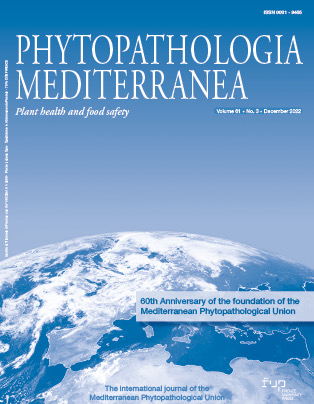Plant Health research collaboration in the Mediterranean region: case studies on citrus tristeza virus, tomato brown rugose fruit virus and Xylella fastidiosa
Published 2023-01-13
Keywords
- Research coordination,
- international collaboration,
- science diplomacy
How to Cite
Abstract
Strengthening Plant Health research is a major challenge for Mediterranean countries. The diversity and fragmentation of the research landscape in this region have weakened the impacts of national efforts. Mediterranean countries can benefit from coordination of research activities to increase efficiency and impacts. The initiative ‘Plant health research priorities for the Mediterranean region’, led by the International Centre for Advanced Mediterranean Agronomic Studies (CIHEAM Bari)1 and the Euphresco network for phytosanitary research coordination and funding2 can promote convergence of national programmes and optimize the use of the scarce funding available to plant health, thus strengthening international cooperation and increasing the excellence and relevance of research.
Downloads
References
Bar-Joseph M., Batuman O. and Roistacher C. (2010). The history of Citrus tristeza virus—Revisited. In: Karasev AV and Hilf ME (eds.). Citrus Tristeza Virus Complex and Tristeza Diseases. APS Press, St Paul, MN, USA. pp. 3–26
Dombrovsky A., Mor N., Gantz S., Lachman O., Smith E. (2022). Disinfection Efficacy of Tobamovirus-Contaminated Soil in Greenhouse-Grown Crops. Horticulturae 8(7): 563
EPPO (2022). EPPO Global Database https://gd.eppo.int/taxon/TOBRFV [accessed on 2022-11-28]
Harper S.J., Dawson T.E. and Pearson M.N. (2010). Isolates of Citrus tristeza virus that overcome Poncirus trifoliata resistance comprise a novel strain. Archives of Virology 155: 471–480
Harper S.J., Dawson T.E. and Pearson M.N. (2010). Isolates of Citrus tristeza virus that overcome Poncirus trifoliata resistance comprise a novel strain. Archives of Virology. 155: 471–480
Harper S.J. (2013). Citrus tristeza virus: evolution of complex and varied genotypic groups. Frontiers in Microbiology, 93: 1-18
Hilf M.E. & Garnsey S.M. (2002). Citrus tristeza virus in Florida: A Synthesis of Historical and Contemporary Biological, Serological, and Genetic Data. Proceedings 15th International Conference of the Organization of Citrus Virologists pp. 13-20 https://escholarship.org/uc/item/0v8463sn [accessed on 2022-11-28]
Karasev A.V., Boyko V.P., Gowda S., Nikolaeva O.V., Hilf M.E., Koonin E.V., Niblett C.L., Cline K., Gumpf D.J., Lee R.F., Garnsey S.M. and Dawson W.O. (1995). Complete sequence of the citrus tristeza virus RNA genome. Virology 208: 511–520
Luria N., Smith E., Reingold V., Bekelman I., Lapidot M., Levin I., Elad N., Tam Y., Sela N., Abu-Ras A. and Ezra N. (2017). A new Israeli Tobamovirus isolate infects tomato plants harboring Tm-22 resistance genes. PloS one, 12(1), p.e0170429
Mawassi M., Mietkiewska E., Gofman R., Yang G. and Bar J.M. (1996). Unusual sequence relationships between two isolates of citrus tristeza virus. Jour¬nal of General Virology 77: 2359–2364
Myers N., Mittermeier R.A., Mittermeier C.G., da Fonseca G.A. and Kent J. (2000). Biodiversity hotspots for conservation priorities. Nature 403(6772): 853-8
Permar T.A., Garnsey S.M., Gumpf D.J. and Lee R. (1990). A monoclonal antibody that discriminates strains of citrus tristeza virus. Phytopathology 80: 224 –228
Salem N., Mansour A., Ciuffo M., Falk B.W. and Turina M. (2016). A new tobamovirus infecting tomato crops in Jordan. Archives of Virology, 161(2), pp.503-506
Skelton A., Frew L., Buxton-Kirk A., Ward R., Forde S., McDonough S., Sewell R., Hodgson R. and Fox A. (2021). Tomato brown rugose fruit virus: survival of the virus and efficacy of disinfection approaches. Final report of the research project PE033a 'ToBRFV: survival of the virus and efficacy of disinfection approaches, accessible from https://projectbluearchive.blob.core.windows.net/media/Default/Research%20Papers/Horticulture/PE%20033a_Report_Final_2021.pdf [accessed on 2022-11-28]







